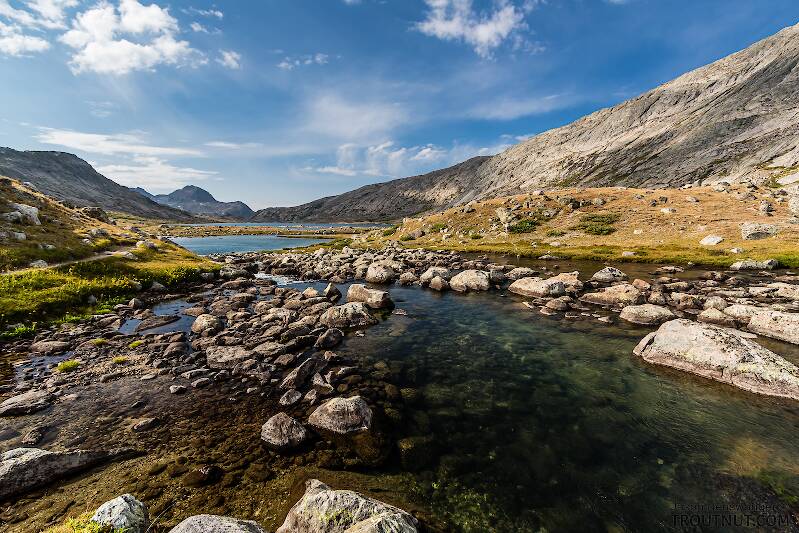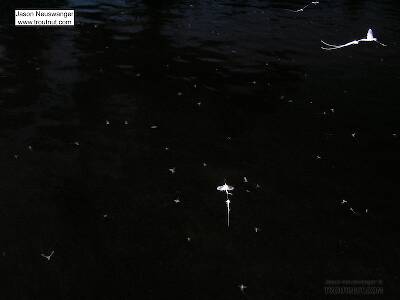
Salmonflies
Pteronarcys californica
The giant Salmonflies of the Western mountains are legendary for their proclivity to elicit consistent dry-fly action and ferocious strikes.


Mayfly Genus Ephoron (White Flies)
Ephoron leukon is most important species in the East and Ephoron album in the West. They overlap in the Midwest. These are the only two mayflies of this genus recognized in the United States, but Caucci and Nastasi in Hatches II report inspecting specimens which did not fit the description of either species.
Where & when
Time of year : August through October; best from late August through September
Preferred waters: Lakes and rivers, warm and cool. Alkaline waters produce the best hatches.
Since these species thrive in warm water as well as cool, they are also important to smallmouth bass fishermen. These mayflies mark an excellent time for topwater fishing, often with Ephoron imitations.
In 55 records from GBIF, adults of this genus have mostly been collected during August (35%), July (35%), September (18%), and June (9%).
In 32 records from GBIF, this genus has been collected at elevations ranging from 618 to 6250 ft, with an average (median) of 3533 ft.
Genus Range
Hatching behavior
The nymphs are very fast to emerge once they reach the surface, and the duns quickly take to the air. They typically hatch, molt, oviposit, and fall spent within a couple hours, sometimes less, and trout are partial to all the adult stages. The males hatch first so that they have time to molt into spinners before the females arrive within the next thirty minutes.Unique among mayflies, the females don't molt -- they mate and die as duns. Because they go straight from the water to the mating flights and back to the water, their legs have atrophied to a weak and nearly useless state. Fred Arbona mentions in Mayflies, the Angler, and the Trout that the males may be so eager that they attempt to mate with emerging females before they even left the water. The amount of commotion caused by their antics makes twitching and skittering one's dry fly an excellent technique.
The Ephoron activity seems to occur everywhere on the river: every riffle, every pool, every run, upstream and down as far as the eye can see.
Spinner behavior
Time of day: Dusk
There is a common misconception that Ephoron mayflies molt into spinners in mid-air almost as soon as they hatch. One of my streamside photos shows several male spinners still trailing their dun shucks as they fly around, which explains how the rumor started. It is physically impossible for a mayfly to fly (which requires use of its wings) while molting (which takes its wings out of commission for a while). The males actually molt quickly after landing on streamside vegetation, and they often take off again before the shuck is completely off of their tails.
Nymph biology
Current speed: Slow to medium
Substrate: Silt or clay
Environmental tolerance: High tolerance for temperatures warmer than trout can stand; low tolerance for pollution
Ephoron Fly Fishing Tips
Some fly shops sell "White Fly Nymph" imitations which look like snow-white Hendrickson nymphs, completely the wrong shape and color for real Ephoron nymphs. A better imitation would look something like a smaller Brown Drake (Ephemera) nymph.Dun imitations have also suffered a loss of realism due to the common names. The real duns have light gray wings over creamy white bodies, but most imitations have bright white wings. Perhaps this has tested better with the trout, but it seems unlikely.
1 Streamside Picture of Ephoron Mayflies:
Discussions of Ephoron
Jonathon
Start a Discussion of Ephoron
References
- Arbona, Fred Jr. 1989. Mayflies, the Angler, and the Trout. Nick Lyons Books.
- Caucci, Al and Nastasi, Bob. 2004. Hatches II. The Lyons Press.
- Fauceglia, Ted. 2005. Mayflies . Stackpole Books.
- Knopp, Malcolm and Robert Cormier. 1997. Mayflies: An Angler's Study of Trout Water Ephemeroptera . The Lyons Press.
- Swisher, Doug and Carl Richards. 2000. Selective Trout. The Lyons Press.


